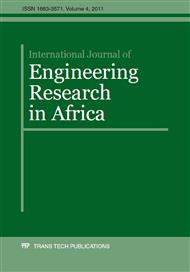p.1
p.15
p.27
p.35
p.59
p.67
p.75
Neuro-Fuzzy Based Modeling of Electrostatic Fields for Harmattan Season in Zaria
Abstract:
This paper presents a Neuro-Fuzzy based modeling of electrostatic fields for harmattan season in Zaria, Nigeria based on online based data capturing mechanism, which involved the use of a data acquisition system interfaced with a digital electrostatic field strength meter (model 257D) and a computer system. The acquired electric field data were captured by the computer using the Microsoft Office Excel Program for twenty-four months (February 2007 – February 2009). The focus of the analysis is determining the effect of environmental factors such as temperature, pressure and relative humidity on the static electric field during the harmattan season. The plots of the electrostatic field against the variation of the environmental factors were used as the qualitative analytical tools and yielded a non-linear relationship. The data was analyzed using Neuro-Fuzzy technique, which is a hybrid intelligent system combining the benefits of computational techniques of Fuzzy Logic and Artificial Neural Networks. The result of the analyses yielded good neural statistical values of Root Mean Square (RMS) of 0.32, Average Absolute Error of 0.18, and Pearson R value of 0.96 for the harmattan scenario, which are reflections of a good model. The result was further buttressed by the 3D plot of the Neuro-Fuzzy based modeling of the experimental parameters. With the insignificant values of the RMS and Average Absolute value, the empirical model gave a fairly good prediction which could be relied upon to predict the electrostatic fields during harmattan in Zaria, Nigeria.
Info:
Periodical:
Pages:
75-85
Citation:
Online since:
May 2011
Authors:
Price:
Сopyright:
© 2011 Trans Tech Publications Ltd. All Rights Reserved
Share:
Citation:


